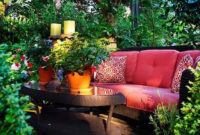Once a structural engineer has confirmed that your roof would be able to withstand the extra weight of a garden you can start planning and constructing it. Take careful measurements and create a plan on paper before you buy anything. You must add extra water-proofing to the surface of the roof and maybe even staging as well before adding any plants.
Although a roof garden can add another dimension to your living accommodation, space will probably still be limited and so you will want to choose plants carefully. You can choose to grow plants that will give you fresh produce or flowers and shrubs that have long flowering periods.
Shrubs, flowers and also crops can be grown in pots, containers, compost bags and maybe even raised beds. You should choose the lightest containers and compost you can find. All of this can be done in an inexpensive way if you recycle containers.
Plastic containers retain moisture better than terracotta; they are also lighter and more frost-proof. The addition of water retaining crystals to compost will reduce the need for watering. If you don’t like the appearance of plastic pots, they can be painted; and if you have a motley collection of recycled containers, they can be painted the same colour to create a co-ordinated colour scheme. The wonderful thing about container gardening is that it gives you the opportunity to choose the exact soil to give any plant the requirements it needs.
You will still need to consider whether a position is mostly in sun or shade before you decide what to plant there – as in any other garden.
Fruit and certain vegetables can be grown up walls or trellises to use all available space. They can even be mixed in with flowers. Some, like marigolds, can help keep pests away from your crops. Fruit trees especially like being trained against brick walls because these retain heat which will help to ripen fruit. A lot of fruit trees and vegetable plants have been bred as dwarf varieties to suit the smaller garden and really can be quite tiny. Some trees even produce more than one variety of fruit from one trunk.
Some crops like herbs, radishes, cut-and-come-again salad leaves and chillies can be grown in very small spaces. Strawberries can be grown in ornamental towers.
Your crops will need well-drained, fertile soil, good airflow and enough water. A greenhouse of any size will extend a growing season but because most roofs would not be able to accommodate such a large structure, cold frames and cloches can be employed to shelter young plants from pests and chilly spring winds instead.
Consider how much time you can spend giving attention to each crop’s needs; some are more self-sufficient than others. Think about when you will be away from home on holiday and when your crops will be ready for harvesting. Because container grown plants need a lot of watering they may not be able to survive for weeks without attention.
Plants on roofs have to either be able to withstand wind or be sheltered from it. They will need more watering than plants in the ground. Be careful where the water drains to if you have neighbours underneath.
Water gardens in the evening or early morning and give regular feed any pot-grown plants, especially later in the summer when the nutrients have been mostly spent from the compost.
On roof tops that really have no shelter from wind, plants that do well by the sea or perhaps New Zealand natives should be successful. Any plant that has thick leaves like laurels or fatsias would do well. Lavender and other plants that like free drainage should also be happy.
If you have very little soil to grow plants in, then you could consider planting wild flowers, alpines or sedums which come in a multitude of colours and will tolerate poor, shallow soil and a certain amount of drought too. Or you might like to grow bonsai trees which like being outside but are restricted in very small pots.
Whatever space is available it will be possible for you to grow something.
Roof gardens can provide an oasis of calm and tranquillity; a wonderful addition to a property, especially in a city.
















































